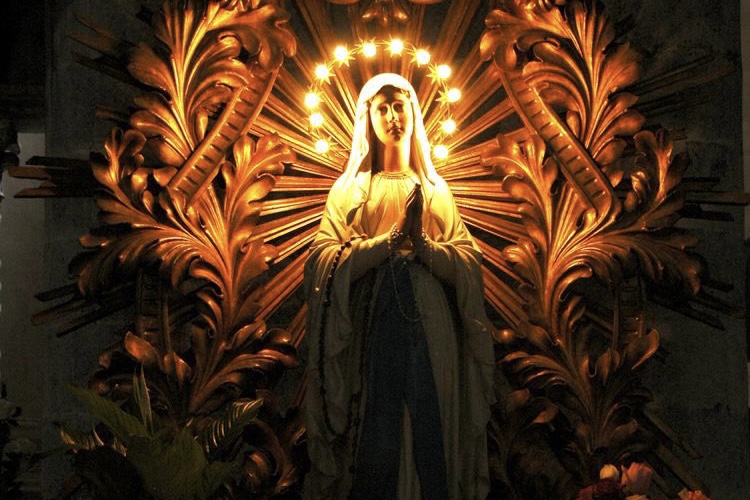If you watch any of the Marvel Comics series of movies, you are probably disappointed at the increasing lack of chastity among the superheroes. There’s obvious exceptions. For example, X-Men’s teleporting Nightcrawler is religious in the movies. In the original comic book, Nightcrawler had even been ordained a Catholic priest. Sadly, today, however, more and more “superheroes” are being produced by “woke” companies under pressure to portray alternative and impure lifestyles that has nothing to do with the plot-line. I imagine even agnostic followers (who aren’t leftists) of Marvel Comic movies are getting tired of the slimy agenda when they just came to the movies to see the good-guys beat up the bad-guys.
I woke up a few weeks ago thinking about how Roman pagans 2,000 years ago must have had the account of the Virgin giving birth to a child presented to them by the early Christians as something of two superheroes. I don’t write this to make a “relevant blog post” comparing Jesus and Mary to two X-Men. I certainly don’t mean to imply the historical reality of the Virgin birth was presented by the earliest Christians as a myth or legend. Of course, the earliest Catholics were all ready to die for the fact that the Virgin birth and bodily resurrection were two historical facts. And many of the early Catholics did die for their insistence on the miracles of the Virgin birth and Resurrection of Jesus Christ. So, when I write that the early Catholics presented their “two superheroes,” I mean the crumbling Roman world must have thrilled at the notion of such purity and miracles. The account of the miracle of the Virgin birth just may have perked-up the typical Roman citizen of the second century, fatigued as he was with his wars and the pleasures of the flesh. The X-Men movies today are getting more impure. The Roman Empire of the 2nd century may just have been ready for completely pure superheroes. And the difference is obvious: Those two (Jesus and Mary) are real. So real that the Christians (even children) were willing to die for this historical fact, singing praises to the Triune God in amphitheaters while confessing such miracles.
The other thing I woke up thinking about on that topic of Mary was this line from St. Paul to the Corinthians: Do not be unequally yoked with unbelievers.—2 Cor 6:14. I started thinking about how we Catholics know that Mary is the spouse of the Holy Spirit. Now, of course, neither Mary nor the Holy Spirit fits under the category of “unbeliever” as found in the above quote from 2 Cor 6:14. But to be “equally yoked” means that you find a spouse who is about the same level of your holiness. Then it hit me: Mary had to be as holy as the Holy Spirit for this to work as the spouse of the Holy Spirit. Of course, Mary is not infinitely holy, as is God-alone. But she had to be commensurately holy to be made the spouse of the Holy Spirit. (Remember, it’s defined Catholic teaching that Mary is the spouse of the Holy Spirit. It’s not just a sweet devotional topic.)
This union was non-sexual. Still, we must consider what the Nicene Creed declares in saying of Jesus Christ that he was incarnatus est de Spiritu Sancto ex Maria Virgine et homo factus est. That is, God-the-Son became man-incarnate of the Holy Spirit by or from (literally, ex, in the Latin of the Creed above) the Virgin Mary. The angel Gabriel describes this most-pure union that is about to happen in the Gospel of St. Luke: The Holy Spirit will come upon you, and the power of the Most High will overshadow you. Therefore, the child to be born will be called holy—the Son of God.—Luke 1:35. This could only be the fruit of the union of two beings who were similar in holiness. Again, Mary is not infinitely holy as is God-alone. And her union with Him was non-physical. But it hit me that for the incarnation to happen, she had to be as stainless as the Holy Spirit. They both had to be immaculate if she was to be the portal of the Incarnation, just as we say imply in the Creed every Sunday.
Yet even Protestants believe in the Incarnation, so how can they not see the supreme holiness of Our Lady?
The early Romans and Greeks could certainly thrill at such holiness, tired as they were with the sins of the flesh. I suspect there came a point in paganism when they no longer desired fake-gods as their paladins, but true historical-figures like Jesus and Mary as their champions. Indeed, the notion of a 14 year old girl giving birth to God-the-Son by exclusively a non-sexual union with God-the-Holy-Spirit must have blown out of the water not only the hope but even the power of those antiquated and violent myths surrounding gods raping humans to create various items in the material world. Yet again in the 21st century, the world has grown tired of her sins of the flesh. It’s time we present the glory of the miracles of the Incarnation, Virgin birth and Resurrection as the most compelling things that have ever happened in human history. This could only happen when she who was “equally yoked” with God-the-Holy Spirit generated the God-man born to destroy the works of the devil.—1 John 3:8.
p/c @PrayTheRosary12
